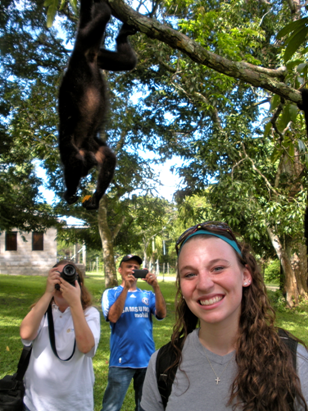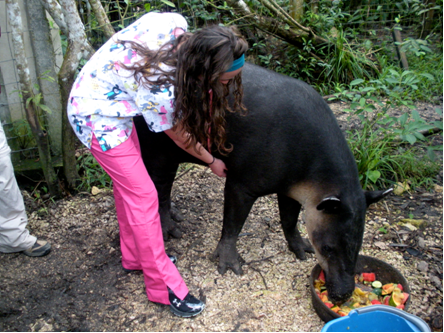Posted: June 14, 2012
Belize is a great place to visit, and an even better place to study wildlife medicine and conservation.

Hanging out with the wild Howler Monkeys at the Community Baboon Sanctuary
From jaguars to toucans to iguanas and all things in between, the rainforest of Belize offered me the best experience with veterinary medicine that I could ever ask for. With the Institute for Sustainable International Studies, six students and I immersed ourselves into the culture of Belize while studying the exotic wildlife that lives there.
I had two weeks to soak up every drop of opportunity that I found in Belize. The majority of my time was spent out in the fields of veterinary and conservation work. We began by familiarizing ourselves with the wildlife fauna and visiting conservation projects, like the Community Baboon Sanctuary and the Green Iguana Project. We spent time in labs, practicing suturing and distance immobilization techniques. We walked around the town and visited the Belize Bird Rescue and the Belize Zoo to de-worm the stray dogs, rescued parrots and toucans, tapirs, margays, ocelots, jaguarundis, and howler monkeys. At the Belize Zoo, we also had a close up encounter with one of the jaguars, Junior Buddy.
 Several unplanned opportunities arose during those two weeks that allowed me to practice veterinary medicine first hand. While visiting the Green Iguana Project, we found a young male iguana with a tail deformity that had led to an infection. We put him under anesthesia for an amputation, and the surgery was successful. One morning, a Mexican hairy porcupine that had gotten into a fight and fallen out of a tree was brought to us for an examination. We treated her wounds, gave her antibiotics and fluids, and splinted her broken arm. She seemed to be doing well, but the next morning, we found out that she had died overnight. We were about to do a necropsy on the porcupine to determine the cause of death, but she took a gasp for air. She was not quite dead yet, so we warmed her up, gave her more fluids, and injected epinephrine into her heart. By the end of the day, the porcupine was alive and eating again! Another day, we were called out to a herpetarium to examine a lethargic American crocodile who had gotten into a fight with another crocodile.
Several unplanned opportunities arose during those two weeks that allowed me to practice veterinary medicine first hand. While visiting the Green Iguana Project, we found a young male iguana with a tail deformity that had led to an infection. We put him under anesthesia for an amputation, and the surgery was successful. One morning, a Mexican hairy porcupine that had gotten into a fight and fallen out of a tree was brought to us for an examination. We treated her wounds, gave her antibiotics and fluids, and splinted her broken arm. She seemed to be doing well, but the next morning, we found out that she had died overnight. We were about to do a necropsy on the porcupine to determine the cause of death, but she took a gasp for air. She was not quite dead yet, so we warmed her up, gave her more fluids, and injected epinephrine into her heart. By the end of the day, the porcupine was alive and eating again! Another day, we were called out to a herpetarium to examine a lethargic American crocodile who had gotten into a fight with another crocodile.  We restrained him, cleaned his wounds, administered antibiotics, and bandaged a broken arm. The species of animals I was able to work with are unique to Belize. As a student with no formal veterinary training, being able to inject animals with medications and set broken bones was an experience that I could only hope to find abroad.
We restrained him, cleaned his wounds, administered antibiotics, and bandaged a broken arm. The species of animals I was able to work with are unique to Belize. As a student with no formal veterinary training, being able to inject animals with medications and set broken bones was an experience that I could only hope to find abroad.
I spent my free time experiencing the town and getting to know the students from the other classes. I visited some of the Mayan ruins in Belize, and we spent an entire day cave tubing and swimming in the Belize River. Overall, I picked up many skills involving veterinary medicine and conservation, and I practiced techniques for working with wildlife. It would be impossible to choose only one word to describe my experience, but the closest would be amazing, unforgettable, and valuable. It is known that Belize is a great place to visit, but it is an even better place to study wildlife medicine and conservation. I loved my time in Belize, and I cannot wait to go back!
Ag Sciences Global
Address
106 Agricultural Administration BuildingUniversity Park, PA 16802
- Email globalag@psu.edu
- Office 814-863-0249
- Fax 814-865-3055
Ag Sciences Global
Address
106 Agricultural Administration BuildingUniversity Park, PA 16802
- Email globalag@psu.edu
- Office 814-863-0249
- Fax 814-865-3055

